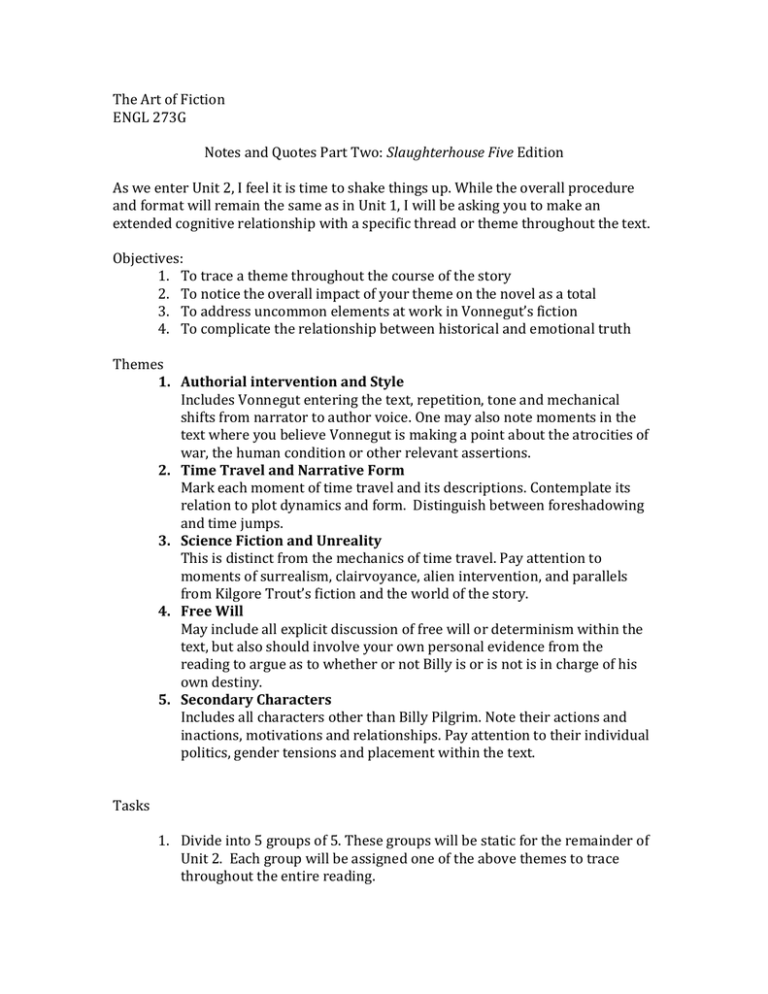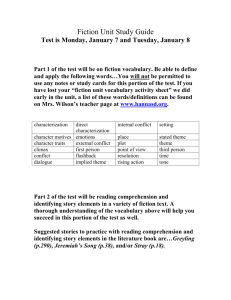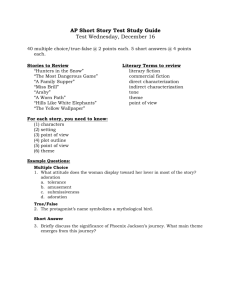Notes and Quotes
advertisement

The Art of Fiction ENGL 273G Notes and Quotes Part Two: Slaughterhouse Five Edition As we enter Unit 2, I feel it is time to shake things up. While the overall procedure and format will remain the same as in Unit 1, I will be asking you to make an extended cognitive relationship with a specific thread or theme throughout the text. Objectives: 1. To trace a theme throughout the course of the story 2. To notice the overall impact of your theme on the novel as a total 3. To address uncommon elements at work in Vonnegut’s fiction 4. To complicate the relationship between historical and emotional truth Themes 1. Authorial intervention and Style Includes Vonnegut entering the text, repetition, tone and mechanical shifts from narrator to author voice. One may also note moments in the text where you believe Vonnegut is making a point about the atrocities of war, the human condition or other relevant assertions. 2. Time Travel and Narrative Form Mark each moment of time travel and its descriptions. Contemplate its relation to plot dynamics and form. Distinguish between foreshadowing and time jumps. 3. Science Fiction and Unreality This is distinct from the mechanics of time travel. Pay attention to moments of surrealism, clairvoyance, alien intervention, and parallels from Kilgore Trout’s fiction and the world of the story. 4. Free Will May include all explicit discussion of free will or determinism within the text, but also should involve your own personal evidence from the reading to argue as to whether or not Billy is or is not is in charge of his own destiny. 5. Secondary Characters Includes all characters other than Billy Pilgrim. Note their actions and inactions, motivations and relationships. Pay attention to their individual politics, gender tensions and placement within the text. Tasks 1. Divide into 5 groups of 5. These groups will be static for the remainder of Unit 2. Each group will be assigned one of the above themes to trace throughout the entire reading. 2. As individuals you will each be responsible to flag, highlight, underline or otherwise mark each instance of this theme in a night’s reading. 3. Once the night’s reading is completed, flip through the section again, this time noting your highlighted passages. Select one you find particularly interesting or important. 4. As with notes and quotes for Unit 1, each night you will type up your selected passage and then write a 200-250 word response. Ask yourself how this theme shines in this portion of the text? Is this one of many examples in that night’s reading or was your theme a bit sparse? How does this passage relate to the text as a whole? ***** If for some reason you cannot detect your theme in that night’s reading choose a passage that best shows character development (or lack there of) Billy Pilgrim is displaying throughout that nights’ reading. 5. Be prepared to share your findings in class! While you won’t necessarily be asked to meet in your groups at the beginning of class your group will be responsible to chime in with particularities of your theme so come prepared!




